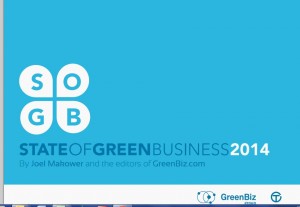This post summarizes 10 trends in sustainable business identified by the good people at GreenBiz.com and TruCost.
It’s their 7th annual report, and I offer this one page summary because the full report is 108 pages.
If you don’t have time to read the whole report, now you’ll know the highlights. If a particular trend resonates with you, here’s a link to the full report.
 Top 10 trends (in no particular order, according to the authors):
Top 10 trends (in no particular order, according to the authors):
- Collaboration Becomes an Accelerator. In plain English, this means that more companies are partnering – up and down the supply chain – to find answers and share best practices around sustainability issues more quickly.
- Chemical Transparency Creates a Window of Opportunity. There is growing momentum to address what companies call “chemicals of concern.” Target, Walmart and Whole Foods are just 3 companies that will require suppliers to more fully disclose ingredients in things like personal care and cleaning products. And some products will be re-formulated.
- Water Rises as a Risk Factor. This goes beyond the obvious concerns about floods and droughts. As hundreds of millions of people climb up the economic ladder, their water use grows. It’s not just because more people need water to drink. The larger factor is the water required to manufacture all the “stuff” they want.
- Shadow Pricing Steps into the Limelight. A “shadow price” is an estimated price of something for which no market price exists. For example, Microsoft has an internal price for carbon. They use it to fund projects that will make the company carbon neutral. CDP (formerly the Carbon Disclosure Project) says at least 30 companies do this.
- The People Side of Sustainability Gets Legs. More companies are integrating social issues into their definition of sustainability as they realize the interconnectedness of the two. So when crops fail due to environmental degradation – and people starve – then when you fix the environmental issue, you usually fix the starvation issue too.
- Food Sustainability Gets a Seat at the Table. “There is nothing more central to sustainability than food”. The question of how to feed a growing population on a planet that is losing cropland has complicated answers. According to the report, there are huge opportunities to address food waste and make agriculture more efficient than it is.
- Employee Engagement Becomes Strategic. According to a study done by Bain, companies that prioritize sustainability initiatives have more engaged employees. A recent study published in the Harvard Business Review shows that companies with the most engaged employees had average operating margins almost triple that of companies with the least engaged employees. Profits, anyone?
- Energy Storage Becomes a Game Changer. Large-scale batteries that can store megawatts of energy — enough to power homes and businesses – are almost here. Such batteries will benefit renewable energy sources, e.g. by providing power when the sun doesn’t shine. And they will make homes and businesses better able to withstand outages or disruptions.
- Cities Become Hotbeds of Promise. The buzzwords “smart cities” have been around for years, but the reality is taking shape. New York City will save $14 million a year by switching to LED lights. Los Angeles saw a return on its investment in installing a “smart parking” system that helps citizens find available spaces returned in just 3 months.
- Buildings and Companies Go Positive. The idea that companies just want to just do “less bad” is giving way to the idea that companies can create really GOOD outcomes – for the business AND the planet. For example, Coke seeks to replenish more fresh water than it uses in the communities where it operates. The ultimate goal for all businesses is to completely integrate sustainability goals with business goals – rather than treating sustainable business operations as a secondary effort.
So there you have it! Which of these trends resonate most with you and your company? Is there a trend that you would add? Let me know in the comments.
